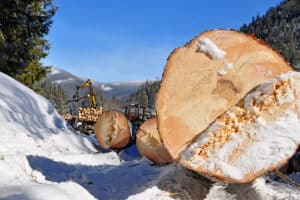Bill Calton, Plum Creek’s Senior Director for Real Estate and Land Management, is cautiously optimistic about the prospects for timberland investors and rural land sales.
Plum Creek, a real-estate investment trust (REIT), is a NYSE-listed company that is the Nation’s largest private timberland owner with 7 million acres. Calton oversees Plum Creek’s non-strategic land dispositions in 18 states along with its recreational lease-management program. He’s based in Atlanta.
Calton is a scheduled speaker at the first LANDTHINK Summit to be held at the Gwinnett Center in Duluth, Ga., on September 30, 2010. He also spent 20+ years in the residential and commercial real estate industry with both Jones Lang LaSalle and Trammell Crow Company.
His unedited answers to my questions appear below:
1. If you were investing your personal money in land for a 10-15 year horizon, what type of land would you buy? Do you prefer some locations to others? Why would you choose this type of land and location over alternatives?
Obviously, we at Plum Creek continue to believe that timberland is a good, long-term, stable investment. And compared to other market indices, timberland historically has proved to be a good inflation hedge. Our strategy as a REIT has certainly been to be geographically diverse. For an individual land investor, opportunities exist in almost every state to buy and invest in land as a diversification play from traditional Wall Street asset classes.
2. Do you think farmland and timberland are currently priced above, at or below market in terms of their intrinsic values (defined however you want), and why? What’s driving current valuations? Do you see a change in valuation drivers in the future?
Most timberland investors today are not placing as much of a premium (if at all) on potential HBU qualities of a parcel like they were in 2004-2007; rather, they are looking more specifically at just the inherent timber characteristics of a tract. Combine that fact with the fall in housing starts (which has negatively impacted stumpage prices), and it’s no surprise that recreational timberland has experienced a decline in prices in the past two years in some of our markets. With that said, as the economy rebounds and housing starts climb back to more stable levels, we expect to see improvement in both timber values and recreational land in general.
3. Do you use or recommend a general valuation formula for determining which investments to make, such as x% of farmland price in current or projected net cash annual income, or x% of acquisition cost in merchantable timber, or projected 10-year pay off of acquisition cost? When using DCF analysis, what minimum target do you recommend? Do you have non-revenue hurdles against which you measure land investment performance?
We look to maximize the value of every acre we own, and while the timber component of land is obviously a major part of our underwriting and valuation, other future uses like conservation, real estate, energy, minerals, mitigation, etc. come into play as we make investment decisions. In other words, each piece of land has its own risks and opportunities, and we evaluate each potential purchase through a “value optimization model” which utilizes many factors and variables that consider our potential Hold period and those risks/opportunities tied to that piece of land. In contrast, for an individual land investor, his/her motivation for buying land may not be purely financial. Many investors, while certainly considering the financial implications of an acquisition, also place an intangible value on raw land purchasing decisions (i.e., they can use it for recreation, hunting, building, etc).
4. Do you anticipate any significant shifts in the market (either positive or negative) for agricultural products and timber fiber/logs during the next 15 years? Do you anticipate any technology change, shift in end uses, environmental issues, trade restrictions/expansion etc. that would positively or negatively affect current production trends and markets for agricultural and timber products?
We expect to see a slow and gradual increase in housing starts. Most economists expect housing starts to recover to about 900,000 in 2011. And, we see some structural shifts in the market.
- There’s going to be a significant decline in Canadian timber supply due to harvesting restrictions related to the Mountain Pine Beetle
- Canadians report they believe that there will be about a 50% reduction by mid-decade in British Columbia harvest from this beetle kill phenomenon that’ll last for 60 years, a significant change in supply.
- There will also be some supply reductions that have already started occurring in Eastern Canada – about a 20% reduction there. So Canada is a big factor.
- Demand growth for wood fiber as a renewable energy source will increase competition for wood fiber. As more power is required from renewable energies, biomass will be a part of the baseload energy regeneration.
- There are also potential value opportunities should carbon markets develop.
5. How have general macro-economic conditions affected the market for HBU land sales in your experience during the last five years? Are you anticipating stronger land sales during the next five years? If so, on what basis?
HBU lands, which are historically higher priced, have taken a back seat over the past year to pure timberland, especially in markets that experienced a very high uplift in HBU prices several years ago (i.e., Florida, Montana). Markets are very “local”, though, and our geographic diversity has allowed us to shift our HBU dispositions to markets that have continued to show some strength and resilience (Gulf South and Lake States).
6. How would a sharp “crash” in commercial real estate and/or loan resets in 2011 affect the market for land sales?
It will not drastically affect real estate dispositions, as 80% of our buyers are cash buyers; however, if the pending commercial loan issue creates a larger macro-economic problem which prolongs the country’s recession, then lower consumer sentiment could certainly have an impact on land sales, which are typically discretionary purchases. On the other hand, we have seen that many of our buyers are, in fact, choosing to buy land as an alternative investment to other traditional Wall Street choices. So if the broader stock markets continue to be unpredictable, land is a dependable, safe investment that investors can feel, use, and touch over their lifetime.
7. To what extent do you think your buyers are affected by interest rates and credit availability?
Only to the extent that rising interest rates and tight credit is affecting their other investments. If those other investments decline in value, then those factors certainly could cause some investors to sit on cash on the “sidelines”.
8. What are the three most important policy changes (including tax) that the federal government could enact that would improve the climate for investing in land?
There are two areas of federal legislation that we are watching carefully. One is the renewable portfolio standard, and the other is greenhouse gas emissions. Right now those policies are joined and in Congress, but we’re not seeing a lot of activity. But at some point, we’ll see Federal policy that addresses both of these issues. From there, we’ll see a move toward lower-based carbon energy. That should benefit our biomass ownership.
LANDTHINK.com is proud to host the first ever LANDTHINK Summit! This groundbreaking event will cover a variety of topics impacting the land industry, including market conditions and trends, recent legislation, conservation, creative financing, land market from a broker’s perspective, the timberland market and more. The Summit brings together industry experts, potential investors, and individuals and companies who own, sell, and invest in land. Summit attendees will gain access to some of the greatest and most valuable resources and thought leaders.
Join us September 30th at the Gwinnett Center in Atlanta, Georgia for a full day of industry education, information and networking with land industry experts and keynote speaker Coach Bobby Bowden. More information on the LANDTHINK Summit can be found at GetLandSmart.com.
This content may not be used or reproduced in any manner whatsoever, in part or in whole, without written permission of LANDTHINK. Use of this content without permission is a violation of federal copyright law. The articles, posts, comments, opinions and information provided by LANDTHINK are for informational and research purposes only and DOES NOT substitute or coincide with the advice of an attorney, accountant, real estate broker or any other licensed real estate professional. LANDTHINK strongly advises visitors and readers to seek their own professional guidance and advice related to buying, investing in or selling real estate.










Thanks for the great post. I look forward to more.